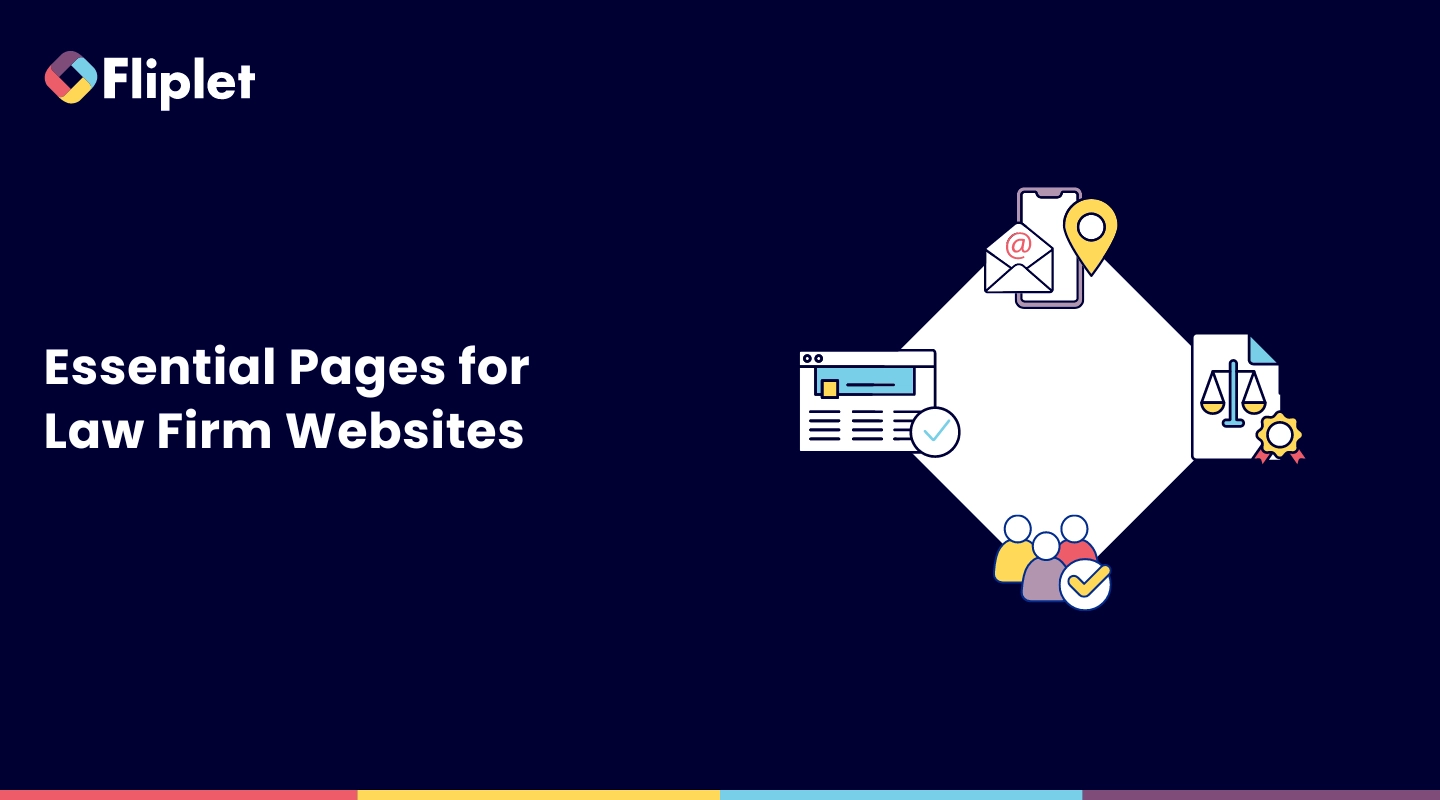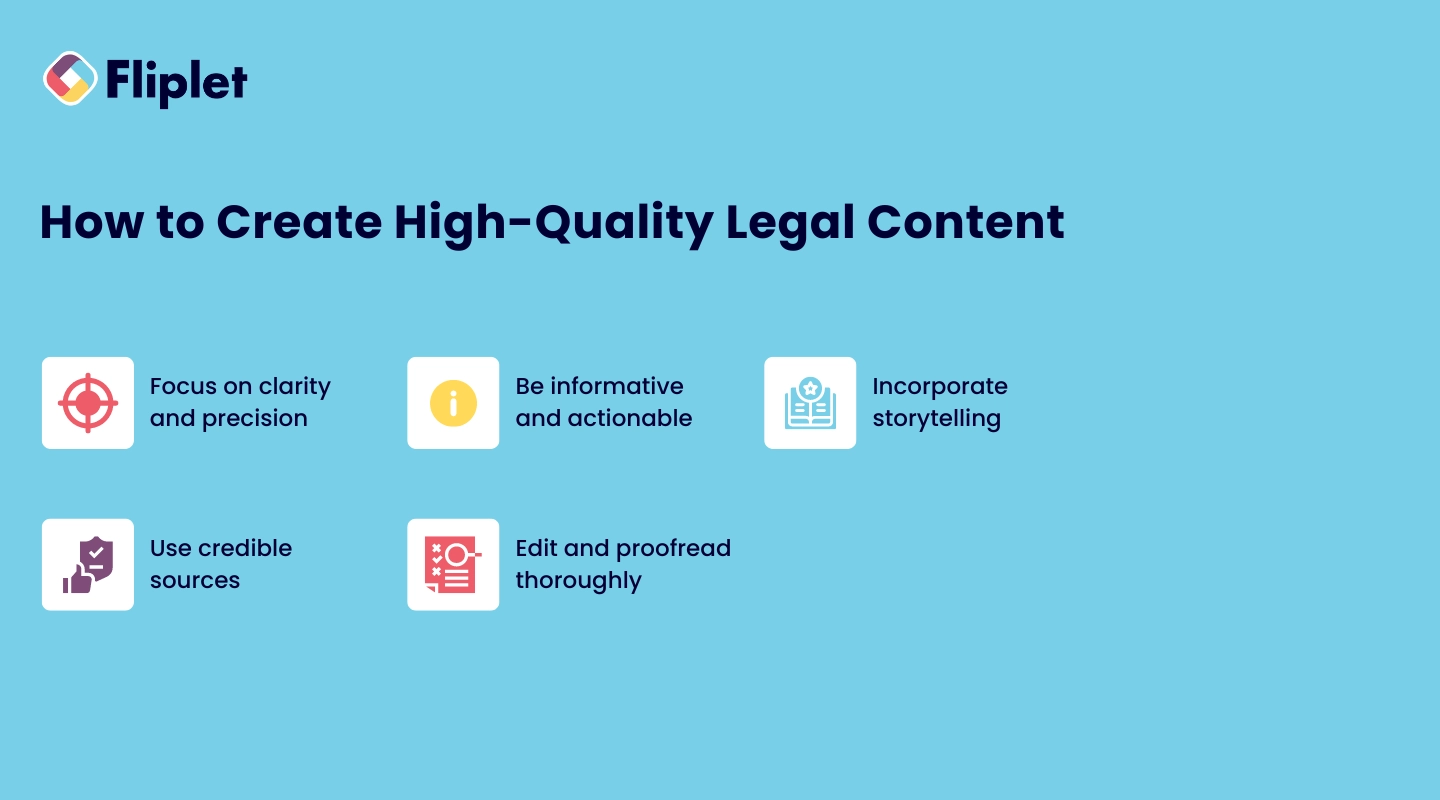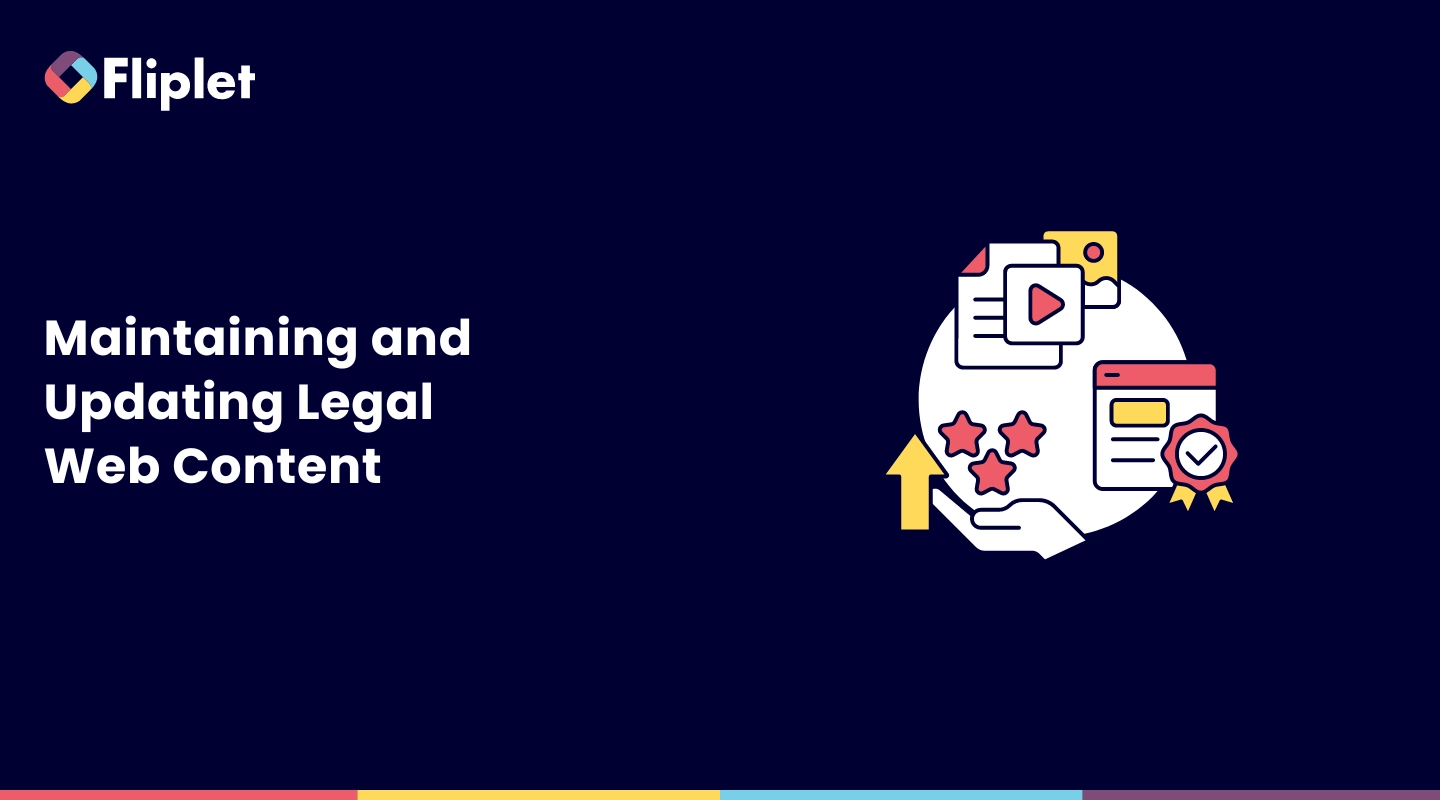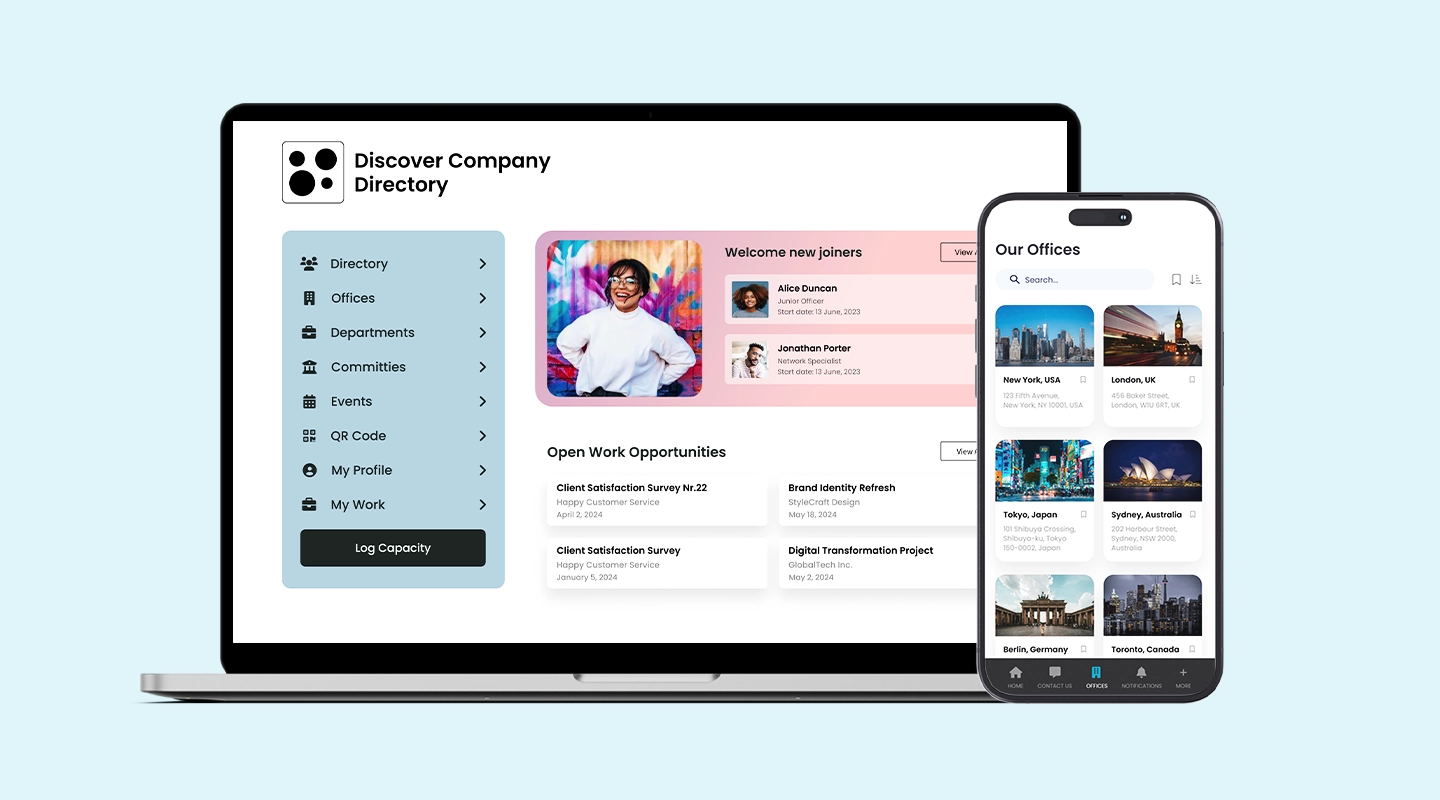A Complete Guide To Elevate Your Legal Website Content

Lisa Broom | Head of Marketing

Well-structured and optimized legal web content can significantly improve your firm’s online visibility, helping potential clients find you more easily and encouraging them to engage with your services.
In this guide, we’ll explore the best practices for legal content that resonates with your audience and supports your firm’s business goals. We’ll also give some guidance on legal content creation that works.
Key Takeaways
- Understanding your target audience is key to creating effective legal web content.
- Essential website pages include Home, About Us, Practice Areas, Attorney Profiles, and more.
- SEO optimization and regular updates are crucial for maintaining content relevance.
- Ethical considerations are vital when creating legal content.
- Fliplet offers versatile tools to help law firms build and manage their legal web content effectively.
Essential Pages for Law Firm Websites

When it comes to structuring your law firm website content, certain pages are essential for building credibility, engaging visitors, and converting them into clients. Each page should serve a specific purpose, providing visitors with the information they need while also reflecting your firm’s brand and values.
Home Page: Your Digital Front Door
The Home page is often the first impression potential clients have of your firm. It should be inviting, informative, and easy to navigate. This page should clearly communicate who you are, what you do, and how you can help your clients. A well-crafted Home page sets the tone for the rest of the website, guiding visitors to explore further.
About Us: Building Trust and Credibility
The About Us page is where you share your firm’s story, mission, and values. It’s an opportunity to build trust with potential clients by showcasing your firm’s history, achievements, and commitment to serving your clients’ needs. This page should highlight what sets your firm apart from others, such as your unique approach, awards, or community involvement.
Practice Areas: Highlighting Your Expertise
Your Practice Areas page is where you outline the specific legal services your firm offers. Each practice area should be clearly defined, with explanations of how your firm can assist clients in those areas. This page not only helps potential clients understand the scope of your services but also positions your firm as an expert in those legal fields.
Attorney Profiles: Showcasing Your Legal Team
Clients want to know who will be handling their cases, making the Attorney Profiles page essential. This page should feature detailed biographies of your legal team, including their qualifications, experience, and areas of expertise. Adding personal touches, such as interests or community involvement, can also help clients feel more connected to your attorneys.
Contact Us: Encouraging Client Engagement
The Contact Us page should make it easy for potential clients to reach out to your firm. Include all relevant contact information, such as phone numbers, email addresses, and office locations. A contact form is also useful for capturing inquiries directly from your website. Ensure this page is accessible from every other page on the site, encouraging clients to get in touch.
Case Studies and Success Stories
Case studies and success stories provide tangible proof of your firm’s capabilities. By showcasing real-life examples of how your firm has successfully handled cases similar to those potential clients may be facing, you build credibility and trust. This page should highlight the challenges faced, the solutions provided, and the positive outcomes achieved.
Blog Posts, Resources, and FAQs
A blog is an excellent way to share your expertise, provide valuable insights, and keep your audience informed about legal developments. The Resources and FAQs sections can offer additional value by addressing common questions and concerns your clients may have. Regularly updating these sections not only helps with SEO but also positions your firm as a thought leader in the legal industry.
Best Practices for Legal Content Creation

High-quality legal content creation requires a strategic approach. By following these best practices, you can ensure that your content not only attracts visitors but also engages and converts them into clients.
1.Understand Your Target Audience
Knowing your audience is the first step in creating effective legal web content. Start by researching who your potential clients are, what legal issues they face, and how they search for legal services online. This understanding will help you tailor your content to address their specific needs and concerns.
- Run surveys: Use tools like Fliplet’s survey mobile app to gather insights directly from your clients.
- Automate feedback forms: Implement Fliplet’s feedback app to continuously collect client opinions and improve your content.
- Collect feedback via email: Regularly engage with your audience through email campaigns to understand their needs better.
- Read industry reports: Stay informed about trends and changes in the legal industry to keep your content relevant.
- Research keywords: Analyze the demand for content topics by researching keywords related to legal services.
- Observe legal forums: Participate in or monitor discussions on legal forums to identify common client concerns and questions.
2.Align Content with Business Goals
Your legal web content should support your firm’s broader business objectives. Whether your goal is to increase brand awareness, generate leads, or enhance client loyalty, each piece of content should be created with these goals in mind. Aligning content with business goals ensures that your website serves as an effective tool in your firm’s growth strategy.
3.Optimize Content for SEO
Search engine optimization (SEO) is crucial for improving your website’s visibility in search engine results. By optimizing your content for relevant keywords, you can attract more visitors to your site. However, SEO is not just about keyword placement; it also involves optimizing meta descriptions, using header tags effectively, and ensuring that your website loads quickly and is mobile-friendly.
4.Analyze Competitor Content
Understanding what your competitors are doing can provide valuable insights into what works and what doesn’t. Analyze the content on other law firm websites to identify gaps in your own content strategy and opportunities for differentiation. This can help you create legal web content that not only meets industry standards but also stands out from the competition.
5.Prioritize Quality Over Quantity
While it’s important to have a robust content library, quality should never be sacrificed for quantity. High-quality content that provides real value to your audience will always perform better than a large volume of mediocre content. Focus on creating well-researched, informative, and engaging content that addresses your audience’s needs and positions your firm as an authority in your field.
6.Promote Your Content Effectively
Creating great legal web content is only half the battle; you also need to ensure it reaches your target audience. Use social media, email marketing, and other digital channels to promote your content. Consider repurposing content into different formats, such as infographics or videos, to reach a wider audience.
How to Create High-Quality Legal Content

Creating high-quality legal web content requires a combination of legal expertise, writing skills, and strategic thinking. Here are some tips to help you create content that resonates with your audience:
- Focus on clarity and precision: Legal topics can be complex, so it’s important to explain them in a way that is easy for your audience to understand. Avoid jargon and use clear, concise language.
- Be informative and actionable: Your content should provide valuable information that helps your audience solve a problem or make an informed decision. Include actionable advice that your readers can apply to their own situations.
- Incorporate storytelling: People connect with stories, so consider incorporating case studies or hypothetical scenarios into your content to make it more engaging.
- Use credible sources: Ensure that your content is well-researched and backed by credible sources. This not only builds trust with your audience but also enhances your firm’s credibility.
- Edit and proofread thoroughly: Errors in your content can undermine your credibility. Make sure to edit and proofread your content carefully before publishing.
If you still feel at a loss, you can consider hiring legal web content writers.
Visual and Multimedia Content for Law Firm Websites
Visual content, including images and videos, plays a crucial role in engaging visitors and enhancing the user experience on your website. Incorporating visual elements into your legal content can help break up text, illustrate complex concepts, and make your legal web content more memorable.
Using Images and Videos to Enhance Content
- Images: Use relevant images to complement your content and make it more visually appealing. For example, include images of your legal team, office, or community involvement to humanize your firm and build trust with potential clients.Example: Pitta & Baione have a gorgeous website that uses images to strikingly tell the story of the people they help—those affected by the terrorist attacks of 9/11.
- Videos: Videos are a powerful tool for engaging visitors and conveying information quickly. Consider creating short videos that explain legal concepts, introduce your attorneys, or showcase client testimonials. Videos can also be used to demonstrate your firm’s expertise and approachability.Example: Hogan Lovells’ website uses video to draw in visitors immediately.
- Infographics: Infographics are an excellent way to present complex information in a digestible format. Use infographics to explain legal processes, illustrate statistics, or summarize key points from your blog posts.Example: Pottenger Law Firm has an entire section set aside for infographics.
Maintaining and Updating Legal Web Content

Your legal web content should not be static. Regular updates and maintenance are essential for keeping your content relevant, accurate, and effective in attracting and retaining clients.
Conducting Regular Content Audits
A content audit involves reviewing all your legal web content to ensure it is up-to-date, accurate, and aligned with your firm’s current goals. Regular audits help you identify outdated information, broken links, or content that no longer reflects your firm’s brand or services.
- How to audit your content for accuracy and relevance: Start by compiling a list of all your website’s pages. Review each page for accuracy, checking for outdated information, legal changes, or shifts in your firm’s focus. Update content as needed to ensure it reflects your current services and expertise.
- Tools and strategies for content maintenance: Use tools like Google Analytics to track the performance of your content and identify areas that need improvement. Content management systems (CMS) like WordPress often have built-in tools for content updates and SEO optimization.
Measuring Content Effectiveness
To ensure your legal web content is achieving its goals, it’s important to measure its effectiveness regularly. Analytics tools can provide valuable insights into how your content is performing and where improvements can be made.
- Importance of analytics in content strategy: Analytics can help you understand which legal web content resonates most with your audience, which pages have the highest bounce rates, and which keywords are driving traffic to your site. This data is crucial for refining your content strategy and improving your website’s overall performance.
- Tools for tracking content performance: Tools like Google Analytics, SEMrush, and Ahrefs offer comprehensive data on website traffic, user behavior, and keyword performance. Use these tools to monitor your content’s success and make data-driven decisions about future content creation.
Ethical Aspects When Creating Legal Content
Ethical considerations are paramount when creating legal web content. As a law firm, your content must be accurate, transparent, and compliant with legal advertising rules. Ethical content creation not only protects your firm from potential legal issues but also builds trust with your audience.
Maintaining Transparency and Accuracy
Transparency and accuracy are the cornerstones of ethical legal web content. Your content should provide clear and accurate information that is easy for your audience to understand. Avoid making exaggerated claims or offering legal advice that could be misinterpreted. Ensure that all content is thoroughly researched and fact-checked before publication.
Using AI for Generating Legal Content
While AI can be a useful tool for content creation, it’s important to use it responsibly. AI-generated content should be reviewed and edited by a qualified legal professional to ensure accuracy and compliance with legal standards.
- Why you shouldn’t rely solely on AI for legal content creation: AI tools can assist with content creation, but they lack the nuanced understanding of legal issues that a human expert provides. Content created solely by AI may miss critical legal subtleties, leading to potential inaccuracies or misinterpretations. Therefore, it’s essential to have a clear AI policy for law firms that outlines how AI should be used in content creation and review processes.
Want to learn more about how law firms can benefit from AI? Check out our article here.
Ensuring Compliance with Legal Advertising Rules
Legal web content must comply with industry standards and advertising rules set by the relevant legal authorities. These rules vary by jurisdiction but generally require that content is truthful, not misleading, and does not create unjustified expectations. Familiarize yourself with the advertising rules in your area and ensure that all content on your website adheres to these standards.
- Best practices for ethical legal web content creation: Always provide disclaimers where necessary, clearly distinguish between informational content and legal advice, and avoid making promises about case outcomes. Ethical legal web content creation not only helps you avoid legal issues but also strengthens your firm’s reputation.
Why Law Firms Prefer Using Fliplet (Web and Mobile App)

Fliplet offers law firms a versatile and user-friendly platform for creating, managing, and optimizing their legal web content. With Fliplet, law firms can easily build custom web and mobile applications that enhance client engagement, streamline content creation, and improve overall website performance.
- Customizable solutions: Fliplet’s platform allows law firms to create tailored solutions that meet their specific needs. Whether you need a survey mobile app to gather client feedback or a feedback app to improve your content, Fliplet provides the tools you need to succeed.
- User-friendly interface: Fliplet’s intuitive interface makes it easy for lattorneys to manage their law firm website content without needing extensive technical expertise. The platform’s drag-and-drop functionality allows you to create and update content quickly and efficiently.
- Scalability: As your law firm grows, Fliplet’s platform can scale with you, offering the flexibility to add new features and functionality as needed. This ensures that your website continues to meet your firm’s evolving needs.
- Comprehensive support: Fliplet offers comprehensive support to help law firms get the most out of their platform. From initial setup to ongoing maintenance, Fliplet’s team is available to assist with any questions or challenges that arise.
Explore Fliplet’s solutions for lawyers and attorneys staff and discover how our platform can help you elevate your legal web content and engage more effectively with your clients.
FAQs
What are the essential pages for a law firm website?
The essential pages include the Home page, About Us, Practice Areas, Attorney Profiles, Contact Us, Case Studies, and a Blog or Resources section.
How can legal content improve my firm's SEO?
Optimized legal content can improve your firm’s search engine ranking, making it easier for potential clients to find you online. This includes using relevant keywords, creating high-quality content, and regularly updating your website.
What ethical considerations should be kept in mind?
Ensure that your content is accurate, transparent, and compliant with legal advertising rules. Avoid making exaggerated claims and clearly distinguish between informational content and legal advice. Also, know how to legally reuse web content. Generally, wording should be significantly changed, though using the same general ideas is fine.
How often should I update my website content?
It’s recommended to audit and update your website content regularly, at least once a quarter. This ensures that your content remains accurate, relevant, and aligned with your firm’s goals.
Should law firms use AI for content creation?
While AI can assist in generating content, it should not be relied upon solely. AI-generated content should be reviewed by a qualified legal professional to ensure accuracy and compliance with legal standards. This is why legal web content writers are still an essential part of the process.





